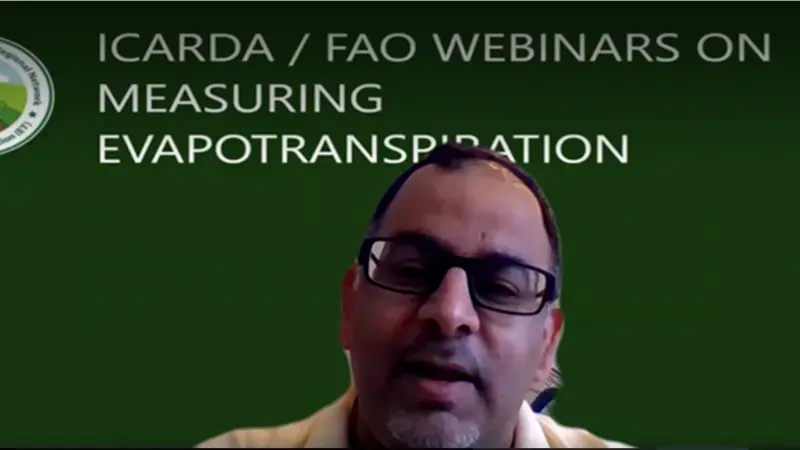ICARDA/FAO SUCCESSFUL EVAPOTRANSPIRATION MEASUREMENT WEBINARS

The webinar series was part of the FAO-funded NENA Regional ETNet Project led by ICARDA and national partners from Egypt, Jordan, Lebanon, Morocco, and Tunisia.
Although Earth is 70 percent water, fresh water is exceptionally scarce, making up just 3 percent of the world’s water reserve. Two-thirds of global freshwater is locked away in frozen glaciers or inaccessible to humans. Over 75% of the accessible freshwater is presently used for agriculture. At the current consumption rate, along with the impact of climatic changes, two-thirds of the world’s population could face water shortages in just three years, especially in dry regions like Central and West Asia, the Middle East, and North Africa (CWANA).
When water is primarily used for food production, several aspects should be addressed including evapotranspiration rates, precipitation, and intensities.
In order to share global information about water use, and especially in CWANA, last September, ICARDA and the Food and Agriculture Organization of the United Nations (FAO) launched a bi-weekly webinar series over three months on the measurement of evapotranspiration led by global experts and attracting over 1,700 international and regional participants.
The webinars covered several evapotranspiration measurement themes including the time and space scale of measurement applications and analyzing their accuracy and suitability for use in arid and semi-arid environments.
Each webinar included a 90-minute lecture and Q&A sessions by international and regional experts focusing on state-of-the-art methods for measuring crop evapotranspiration, each method’s specific problems for correct application in the region to adapt to climate change, and the increasing scarcity of freshwater for sustainable agriculture.
For more information, you may contact Dr. Vinay Nangia, Research Team Leader – Soil, Water, and Agronomy, and coordinated this webinar series with Dr. Ajit Govind and Rania Gamal.
SCHEDULE AND LINKS TO ACCESS RECORDINGS
|
Date of webinar |
International Speaker |
Topic |
Regional Speaker |
Recording Access Link |
|
September 15 |
Gary Marek (US Department of Agriculture) |
Comparison of ET estimates from a surface layer scintillometer and a large weighing lysimeter |
Alaa Mosad (ARC-Egypt) |
|
|
September 29 |
Dennis Baldocchi (University of California - Berkeley) |
Lessons Learned about Ecosystem Evaporation from a Global Network of Eddy Covariance Sites |
Rim Zitouna (INGREF-Tunisia) |
|
|
October 13 |
Steven Evett (US Department of Agriculture) |
ET by Soil Water Balance: Weighing lysimetry and soil water sensing approaches |
Naem Mazahrih (NARC-Jordan) |
|
|
October 27 |
Suat Irmak (Pennsylvania State University) |
Fundamentals and Measurements of Surface Energy Balance, including Evapotranspiration, with the Emphasis on Bowen Ratio Energy Balance System |
Ihab Jouma (LARI-Lebanon) |
|
|
November 10 |
Christopher Neale (University of Nebraska - Lincoln) and George Burba (Li-Cor Bioscience) |
ET Flux Networking: Latest Tools for Connecting Flux, Remote Sensing & Modelling Communities via Time- and Space-Synchronized Datasets |
NO REGIONAL PRESENTATION |
|
|
November 24 |
Bill Kustas (US Department of Agriculture) and Joseph Alfieri (US Department of Agriculture) |
ET Measurement Uncertainties and Implications for Model Validation |
Ali Hammani and Ehssan Elmeknassi (IAV Hassan II-Morocco) |
